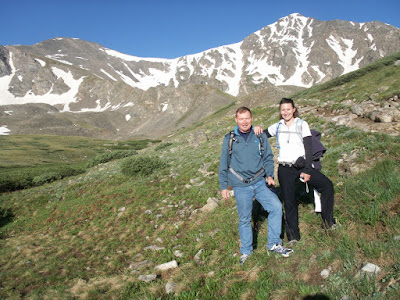
I am fascinated with the terrain and features of this mountain. It has breathtaking granite faces, sheer drops, residual snow, beautiful trees, and at the summit, a stunning 360 degree view of the surrounding mountains.
The route I first tried is, to put it simply, a sonofabitch. The first quarter mile of extreme steepness combined with tangled brush and no trail will break you if you can be broken. The next quarter mile is just as steep, but is a huge field of massive granite boulders, some as large as a house. It's fun choosing the next boulder to clamber over, but you are still headed very steeply up, and a misstep could very easily result in a broken leg or arm. After crossing what I now refer to as the BFR field, the route is open and clear with ankle-shin height scrub sagebrush, beargrass, and decomposing granite, but still extremely steep, for another 3/4 mile. Lots of huffing and puffing, and your legs will really feel it. Gradually (not gradually enough for my legs and lungs), it gets less steep as it intersects another ascending ridge. Here is the first stunning view- a large granite dike or outcrop, topped with jagged spires, towering over a cirque with an alpine lake at the bottom. The top of the granite tower is 900 feet higher than the outlet of the cirque, just 4/10 of a mile away. The route then follows the steep ridge behind this cirque to the main north-south ridge, at which point the stunning views one has seen earlier are instantly forgotten, or demoted, as the three summits are now in view. The grandeur from that first vantage point is breathtaking, stunning, awe inspiring, insert any other well-worn cliche here, words still cannot properly convey the effect of that first view. Because of the steepness and extent of the terrain surrounding them, the summits and the near-vertical granite faces plunging into the cirque below are not visible from anywhere but this and one other very distant point. The view is so markedly different from anything around, and is hidden so one is not just seeing it from afar and simply getting closer during the long slog uphill, but instead suddenly appears, a truly magnificent award for such exertion.
In preparing for the hike, I had reconnoitered a few routes on the ground and on a map, and decided to try this one, which apparently no one else uses. Other posts regarding this summit here and here refer to following a ridge more to the north of mine- less steep, but quite a bit more distance through underbrush, which makes me think there might be a trail. Anyway, I have now hiked my route twice, and I like it- it is taxing, but relatively short, and very, very rewarding.













